Introducción
pantallas led have quietly become the new favorite in cinemas and theaters. They’re more than just an alternative to traditional projection screens.
They’re a key technology that enhances the viewing experience and deepens audience immersion.
From film quality to escenario effects, LED screens are bringing about an audiovisual revolution. So, why are cinemas and theaters increasingly favoring LED screens?
Tabla de contenido
1. Why are LED screens replacing traditional projection screens?
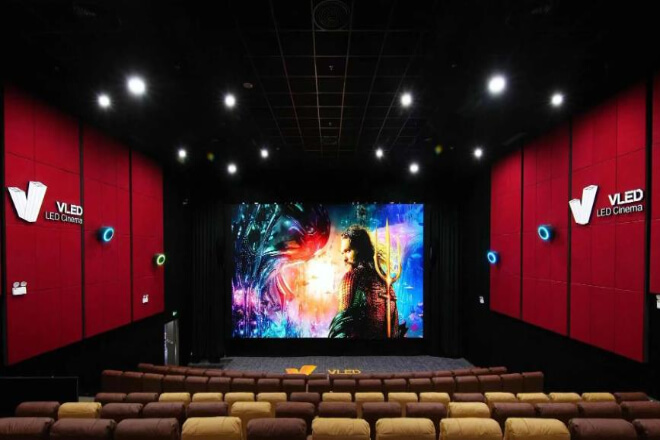
With the continuous advancement of technology, LED screens are quietly replacing traditional projection screens and becoming the new favorite in the display industry.
First, LED screens’ brillo far surpasses projection screens. Projection screens require a darkened room to display their best results; they become blurry as soon as a light source is applied.
LED screens, on the other hand, are resistant to light and maintain a clear, bright image even on a bright day, making them the perfect companion in bright environments.
Regarding color, the vibrant colors of LED screens completely surpass those of projection screens. Projection screens’ colors are often limited by the projector, resulting in a less vivid display.
LED screens, on the other hand, can reproduce more realistic colors and present a richer sense of depth.
Movies, games, and even commercial displays can deliver more stunning visuals, making you feel like you’re truly immersed in the action.
Not only that, but LED displays also have a much longer lifespan than projection screens. Projectors require bulb replacement after a while, resulting in high maintenance costs.
LED displays, on the other hand, are far more durable, and their modules can be replaced individually, eliminating the need for frequent repairs, saving both time and money.
LED displays offer exceptional image uniformity. Projection screens can exhibit shadows or focus shifts, impacting the viewing experience.
LED displays guarantee consistent image clarity from every angle, offering unmatched stability.
Most impressively, LED displays can seamlessly connect to create ultra-large, immersive displays. Traditional projection screens often have gaps when connected, impacting the overall effect.
LED displays, however, seamlessly connect to create a panoramic, complete, and stunning visual experience.
In short, LED displays, with their superior brightness, color, lifespan, image uniformity, and connection capabilities, are easily replacing traditional projection screens and becoming the new favorite in the display industry.
Whether for commercial displays or entertainment, LED displays offer higher-quality visuals and a futuristic feel.
2. How do LED screens enhance the viewing experience in cinemas and theaters?
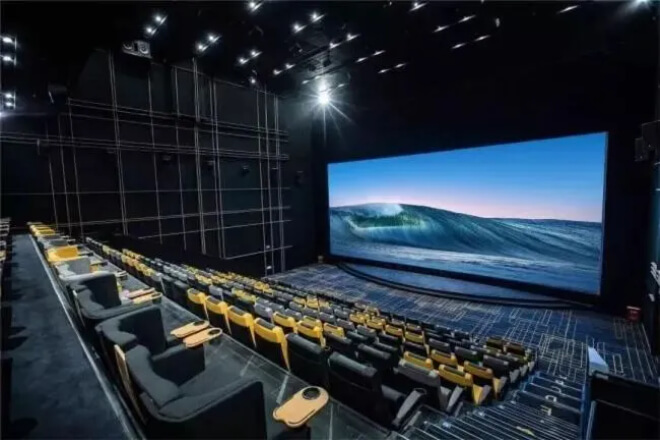
1). 4K/8K Ultra High Definition Display
No more worrying about blurry images and pixelated textures! 4K and 8K Ultra High Definition displays deliver crystal-clear details, with sharp edges and even the finest textures on actors’ skin.
From action scenes to close-ups, LED screens deliver flawless visuals, giving you unprecedented sharpness. The detail is so rich you’ll wonder if you’re watching a reality show!
2). HDR High Dynamic Range
HDR technology delivers perfect brightness and shadow detail. You’ll never miss details in dark scenes, such as late-night streets or subtle movements in dim corners.
Highlights are less glaring, while shadows remain clearly visible. Every detail is vivid and layered, creating a more natural and realistic image.
3). Immersive Visual Experience
The 360-degree immersion provided by LED screens makes you feel like you’ve entered another world.
The large screen’s visually immersive effect makes the audience feel as if they’re right there in the action. The visuals shift with the plot, captivating them completely.
Whether it’s fast-paced action shots or slow-paced plot developments, the LED screen seamlessly blends into the cinema’s atmosphere, drawing you closer into the story.
4). Supports 3D and interactive content playback
In addition to conventional 2D displays, LED screens also support 3D playback, offering a deeper visual experience.
Whether it’s 3D movies or interactive content, LED screens can easily handle it.
For example, in some theaters, audiences can not only watch the movie but also participate in the performance, with the screen and escenario interacting to create a richer and more diverse performance experience.
5). Integrating with the sound system to create a fully integrated audiovisual experience
The perfect synergy between the LED screen and the sound system delivers an unprecedented audiovisual feast.
The synchronized image and sound allow audiences to fully experience every detail of the movie or performance.
From ambient sound effects to the actors’ dialogue, to the intensity of each fight scene, the seamless integration of LED screens and the sound system allows you to not just “watch” a movie, but “be there.”
3. Innovative Applications of LED Screens in Theater Stages
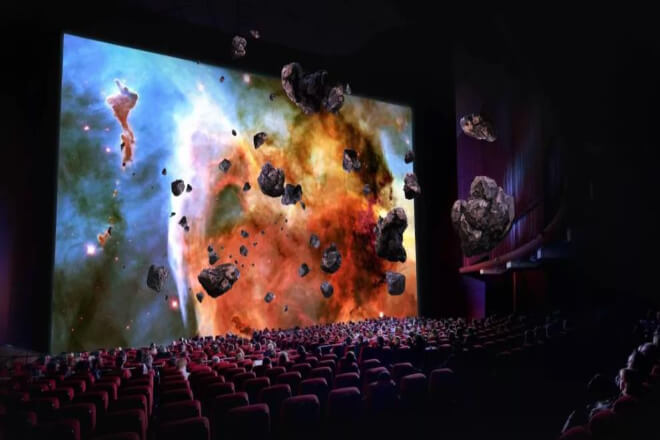
Traditional stage sets often require significant time and labor to construct, and once finalized, they cannot be adjusted flexibly.
LED screens, however, can easily replace these fixed backdrops, dynamically switching as the plot unfolds.
Whether transitioning from one city to another, or from indoors to outdoors, LED screens can create dynamic backgrounds that instantly transform the stage’s atmosphere and environment, giving the audience a sense of being right there in the action.
Traditional stage effects are often limited to lighting and scenery, but LED screens can interact with actors’ performances in real time, enhancing the expressive power of the stage.
For example, actors can “fight” with virtual elements on the screen or interact with characters in the background. These visual effects make the actors’ performances more vivid and powerful.
Audiences not only witness the actors’ performances but also experience richer scene changes, greatly enhancing the stage’s expressiveness and immersiveness.
On traditional stages, sets are often monolithic and difficult to adjust flexibly. LED displays, however.
Can be controlled in zones, allowing for localized video or lighting effects to be displayed as needed, even allowing for different images to be displayed in different areas.
This flexibility allows directors and designers greater creative freedom, enabling them to create more layered and varied stage effects, making each performance unique.
By combining augmented reality (AR) and virtual stage technology, LED displays can create a fully immersive stage environment.
The seamless integration of actors and virtual elements delivers an unprecedented visual and auditory experience.
Imagine actors suddenly “walking” into a virtual city street or interacting with virtual characters.
The entire stage becomes a completely open, interactive world, breaking the limitations of traditional stage performance and offering audiences a highly imaginative experience.
Traditional stage sets are expensive to build and transport, but LED displays can significantly reduce these costs.
Because LED screens can present various scenes themselves, there’s no need to carry heavy sets and props, reducing transportation and construction costs.
Furthermore, LED displays are much easier to install and remove than traditional sets, significantly improving performance efficiency and allowing theaters to prepare for multiple performances in a shorter timeframe.
4. How to Choose the Right LED Solution for Different Types of Cinemas and Theaters?
With the continuous advancement of LED technology, different types of cinemas and theaters need to choose the most appropriate display solution based on their specific needs.
You might be wondering, how should LED be selected for commercial cinemas, IMAX theaters, and even multi-purpose performance halls?
Don’t worry, we’ll analyze each one and ensure you have a clear choice!
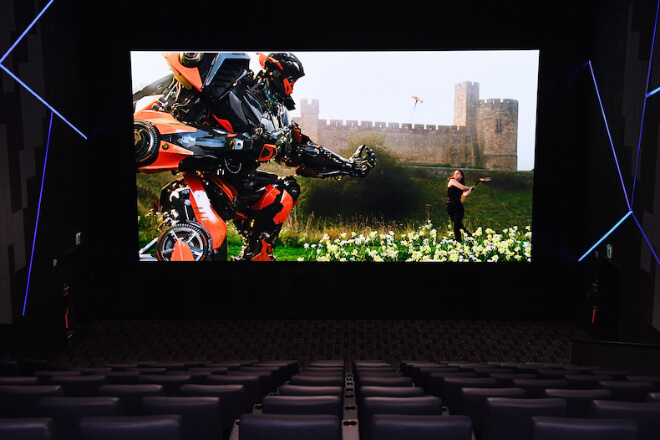
1) Commercial Cinemas
For commercial cinemas, image quality is paramount. The resolución and contrast of an LED display determine the level of detail the audience can see.
Imagine being able to see every detail of a hair on a large screen, with dark areas clearly visible, highlights perfectly balanced, and colors so vibrant that every scene in the movie comes alive.
High-resolution and high-contrast LED displays ensure flawless visuals for every movie, giving audiences a clearer view and a more intense experience.
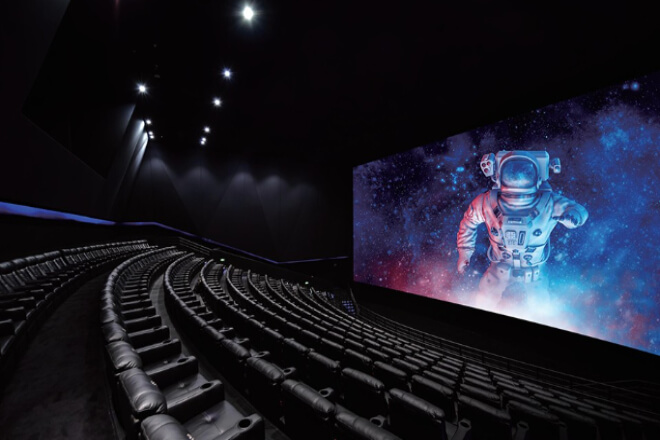
2) IMAX and Giant Screen Theaters
The large-screen displays of IMAX and giant screen theaters make high refresh rates and splicing technology essential for LED displays.
Just imagine, even a slight delay or uneven seams in the picture during a movie on a massive screen would significantly diminish the audience’s experience.
Un alto frecuencia de actualización ensures a smooth, stutter-free picture, while precise splicing technology eliminates gaps and ensures a seamless image from every angle.
This allows the truly stunning IMAX experience to be fully realized and audiences to be fully immersed.
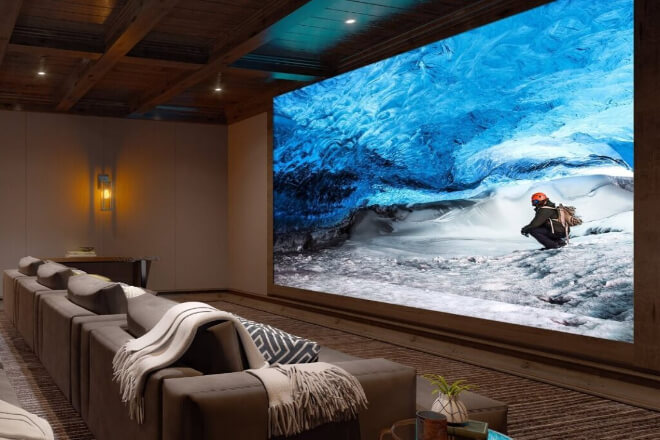
3) Small and Medium-Sized Theaters
For small and medium-sized theaters, space is often limited, making lightweight, easy-to-install LED screen solutions crucial.
Compared to traditional, heavy sets, LED screens can be quickly installed and dismantled, offering greater flexibility in placement.
Not only does this save time, but it also allows you to fully utilize every inch of space.
Most importantly, this flexibility allows for quick adaptation to different performance scenarios, whether it’s a play, a concert, or other performance formats.
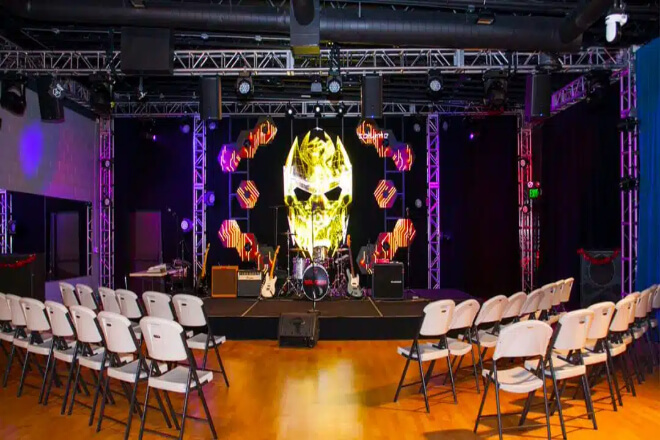
4) Multi-purpose Performance Halls
Multi-purpose performance halls have more complex requirements, requiring LED displays that can be quickly adapted to suit different events.
Choosing a mobile LED display is crucial, allowing for the screen’s size, shape, and position to be adjusted at any time, and even removable and replaceable to accommodate diverse performance needs.
Furthermore, the LED display must support various video and live content formats, making it easy to showcase any performance.
5) Immersive Cultural and Tourism Spaces
For cultural and tourism projects, the immersive quality of LED displays is crucial.
Combining spherical or curved LED screens creates a 360° experience, as if the audience is completely enveloped in a virtual world.
Whether it’s a virtual tour or an immersive performance, the 360° field of view allows the audience to experience each scene more deeply, as if they were there firsthand.
5. The Long-Term Value of LED Screens from an Investment Perspective

In cinemas and theaters, choosing the right LED screen isn’t just about the immediate display quality; it’s also about long-term return on investment.
From reducing operating costs to enhancing brand image, LED screens offer numerous long-term benefits. Let’s examine the benefits of LED screens from an investment perspective.
1) Lower Energy Consumption, Saving Operating Costs
Traditional projectors and other display devices typically consume large amounts of electricity, while LED screens are significantly more energy efficient.
LED screens offer high brillo and low energy consumption, maintaining low operating costs even when deployed on a large scale.
For cinemas and theaters, reducing energy consumption directly translates to lower annual operating expenses, thereby improving overall profitability.
2) Flexible Content Reuse, Supporting a Variety of Performances
LED screens offer high content reusability, making them adaptable to various applications, from film screenings to stage performances, conferences, and advertising.
This means that cinemas and theaters can use LED screens not only for film screenings but also for stage presentations, interactive experiences, and brand promotions, significantly increasing the frequency and efficiency of equipment use.
A one-time investment yields long-term benefits, and the diverse content allows for maximum utilization at every performance.
3). Extending Equipment Lifecycle and Reducing maintenance
Compared to traditional projectors, LED screens have a significantly longer lifespan. They maintain high-quality display quality over extended periods, reducing the need for lamp replacements and equipment repairs.
Because LED modules can be individually replaced, repairs in the event of a malfunction are much easier and less expensive.
This durability and low maintenance make LED screens an ideal long-term investment, helping cinemas and theaters reduce operational risks and repair costs.
4). Strengthening Brand Technology and Audience Satisfaction
With the digital transformation, audiences’ expectations of cinemas and theaters are increasingly high.
LED screens not only enhance visual quality but also reinforce a brand’s sense of technology and modernity.
Through high-quality displays, cinemas and theaters can provide a more impactful and immersive viewing experience, thereby increasing audience satisfaction and loyalty.
For brands, this innovative display method can convey an image of “cutting-edge technology” and “high-end quality,” helping them stand out from the competition.
5). Helping Cinemas and Theaters Achieve Digital Upgrades
Choosing LED displays is a crucial step in the digital transformation of cinemas and theaters.
It not only improves image quality and presentation but also provides greater flexibility for post-production content creation and management.
Through digital management and content updates, cinemas and theaters can easily schedule and adjust programming, providing a personalized viewing experience.
As technology continues to evolve, so too will LED displays, helping the industry keep pace with the digital trend and improving overall efficiency.
6. Conclusion
Overall, LED displays not only provide cinemas and theaters with higher-quality visuals.
But also transport audiences into a more realistic and impactful world through ultra-high-definition imagery, immersive experiences, and interactive content.
From reducing operating costs to enhancing brand image, the advantages of LED displays are clear.
Por último, para obtener más información sobre las pantallas LED, Por favor póngase en contacto con nosotros.
